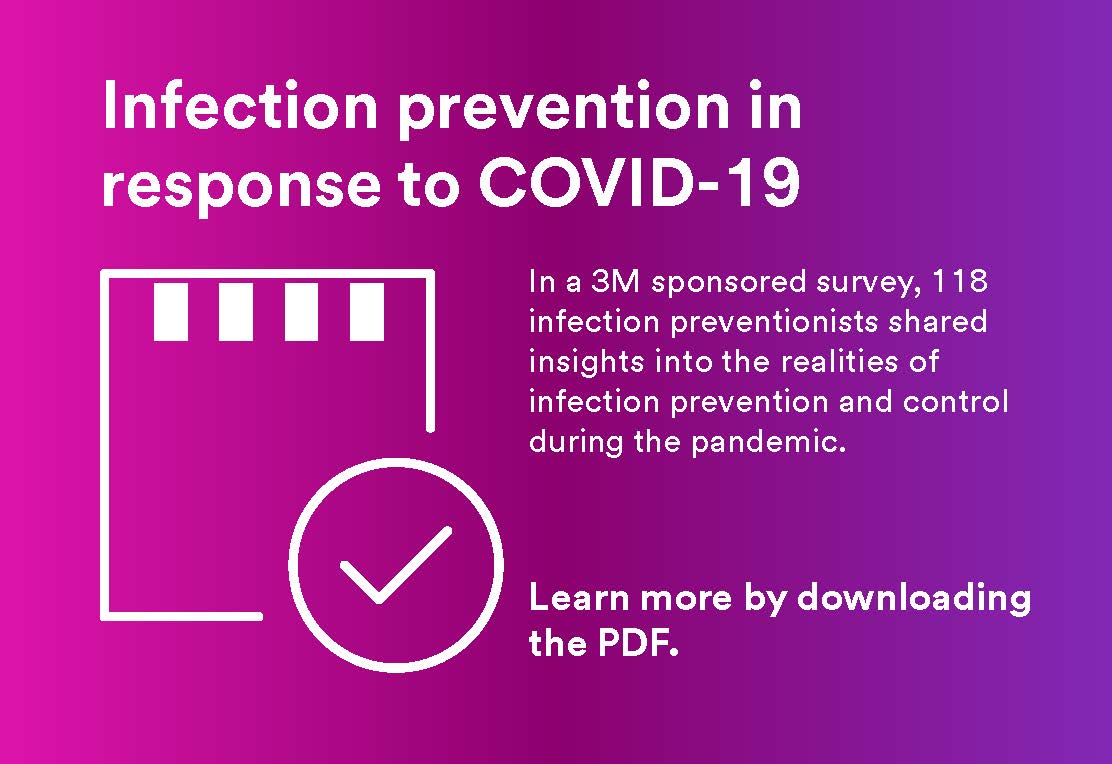
“Buckle up boys – safety first.”
My three sons have heard this phrase a lot over the years. The other thing they’ve frequently heard? Reminders about hand hygiene. I know my sons have heeded my safety reminders because now they remind me to keep safe by buckling up and washing my hands.
As an infection preventionist (IP), I am used to focusing on safety. My trust in processes and technologies drive my decision making – both as a consumer and healthcare professional.
Then, everything changed.
With the emergence of the severe acute respiratory syndrome coronavirus 2 (SARS-CoV-2) and subsequent proliferation of Coronavirus Disease 2019 (COVID-19) our focus shifted, and we had to adapt and change our approaches to infection prevention at a pace not experienced previously.
A recent survey of IPs, sponsored by 3M, demonstrated that while important, the ability to focus on HAI prevention efforts related to central line-associated blood stream infection (CLABSI), catheter-associated urinary tract infection (CAUTI), surgical site infection (SSI), and C. diff has decreased as organizations pivoted focus to help keep patients and staff safe from contracting or spreading the contagion the world now faces. Most survey respondents acknowledged the need to continue focusing on HAIs, despite relaxed mandated reporting requirements, but they simply did not have the staff, resources or time available to do so.
Infection prevention realities today
Many of the basic infection prevention principles (e.g. hand hygiene, environmental cleaning and disinfection, properly using personal protective equipment and respiratory etiquette) we stress as IPs are now at the forefront of many minds. My ambition is for the practice of these principles to become automatic in both healthcare settings and in the general public – similar to buckling up when starting your car.
As our public and healthcare facilities resume life within a new COVID-19 framework, we as IPs and healthcare professionals have to maintain our agility to adapt to the frequent releases and modifications to guidelines and new practices – many of which take us out of our historic comfort zones:
- Items such as filtering facepiece respirators, once viewed as single use items, are now being reprocessed and reused within various facilities as a crisis strategy within the scope of emergency use authorizations.
- Elastomeric respirators, which are widely used within industrial spaces, are now increasingly being utilized in healthcare settings.
- Airborne Infection Isolation Rooms (AIIRs) may have been — or currently are — in short supply and many facilities have innovated safe spaces around patients needing airborne isolation.
- Large influxes of patients mean single-patient rooms may not always be possible.
All the while, healthcare teams must balance COVID-19 response with HAI prevention in such a way that addresses one’s organizational situation and any governmental requirements in the pursuit of providing a safe environment. We simply cannot ignore other risks to patient health and safety while focusing on controlling contagion spread. That’s asking a lot of healthcare teams already pushed to the limit with resources.
It’s why 3M is working to help streamline the solutions and education we offer to IPs as they approach current and future priorities related to COVID-19, HAI prevention, and other initiatives.
As we navigate this historic time, we must keep our eyes on the road ahead and rest assured that our partnerships and technologies will continue to help keep our patients safe as we combat the spread of COVID-19. For those of you on the front lines of patient care, thank you for your tireless commitment and your courage.
Please stay safe, buckle up, and continue to perform hand hygiene. You can learn more about 3M’s approach to infection prevention here.

